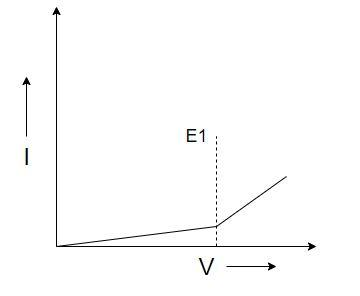
The graph represents a current- voltage behavior of a water- voltmeter. Spot the correct explanation:

A) Dissociation takes place till ${E_1}$ and it obeys Ohm’s law thereafter
B) Ohm’s law is not valid for low voltage
C) Ohm’s law is obeyed but only for potential difference larger than back emf
D) Electrolytes do not obey Ohm’s law
Answer
217.8k+ views
Hint: The ohm’s law can be interpreted in a graph with voltage in the X- axis and current in the Y- axis. When the Ohm’s law is obeyed, the graph will be linearly increasing with voltage.
Complete solution:
Let’s look at what Ohm's law discusses about. According to Ohm’s law, the current across the conductor is directly proportional to the voltage across the two points. Therefore drawing a graph plotting voltage on the X- axis and current on the Y- axis, the graph will be a linear graph. The current increases linearly with the voltage. And the slope of the graph will give the resistance.
Thus $R = \dfrac{{\Delta I}}{{\Delta V}}$
The value of the resistance will be constant according to the Ohm's law. If it has different values it says that the Ohm’s law is not obeyed.
Here, in this graph before the back emf ${E_1}$ is induced, the current is increasing at a smaller rate with respect to voltage. For larger increases in current, only a small change in current. Thus the graph is not linear. The Ohm’s law is not obeyed here. But when a back emf is induced, the current changes with respect to the voltage. The graph is linear and it obeys the Ohm’s law.
Therefore, Ohm’s law is obeyed but only for potential differences larger than back emf.
The answer is option C.
Note: The back emf is the electro motive force which is induced due to the potential difference. It will oppose the change in current induced due to the voltage. The resistance of any conductor is the slope of the I-V curve. For a resistive circuit the resistance i.e. the slope is constant.
Complete solution:
Let’s look at what Ohm's law discusses about. According to Ohm’s law, the current across the conductor is directly proportional to the voltage across the two points. Therefore drawing a graph plotting voltage on the X- axis and current on the Y- axis, the graph will be a linear graph. The current increases linearly with the voltage. And the slope of the graph will give the resistance.
Thus $R = \dfrac{{\Delta I}}{{\Delta V}}$
The value of the resistance will be constant according to the Ohm's law. If it has different values it says that the Ohm’s law is not obeyed.
Here, in this graph before the back emf ${E_1}$ is induced, the current is increasing at a smaller rate with respect to voltage. For larger increases in current, only a small change in current. Thus the graph is not linear. The Ohm’s law is not obeyed here. But when a back emf is induced, the current changes with respect to the voltage. The graph is linear and it obeys the Ohm’s law.
Therefore, Ohm’s law is obeyed but only for potential differences larger than back emf.
The answer is option C.
Note: The back emf is the electro motive force which is induced due to the potential difference. It will oppose the change in current induced due to the voltage. The resistance of any conductor is the slope of the I-V curve. For a resistive circuit the resistance i.e. the slope is constant.
Recently Updated Pages
Arithmetic, Geometric & Harmonic Progressions Explained

Cartesian Form of Vector Explained: Formula, Examples & Uses

Apparent Frequency Explained: Formula, Uses & Examples

Calorimetry: Definition, Principles & Calculations

Centrifugal Force Explained: Definition, Formula & Examples

Charge in a Magnetic Field: Definition, Formula & Examples

Trending doubts
JEE Main 2026: Application Form Open, Exam Dates, Syllabus, Eligibility & Question Papers

Derivation of Equation of Trajectory Explained for Students

Hybridisation in Chemistry – Concept, Types & Applications

Understanding the Angle of Deviation in a Prism

Understanding Collisions: Types and Examples for Students

Understanding Atomic Structure for Beginners

Other Pages
JEE Advanced Marks vs Ranks 2025: Understanding Category-wise Qualifying Marks and Previous Year Cut-offs

How to Convert a Galvanometer into an Ammeter or Voltmeter

Ideal and Non-Ideal Solutions Explained for Class 12 Chemistry

Degree of Dissociation: Meaning, Formula, Calculation & Uses

Understanding Electromagnetic Waves and Their Importance

Understanding Average and RMS Value in Electrical Circuits




